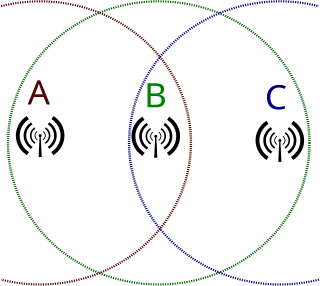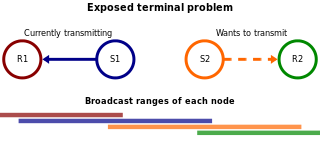
Carrier-sense multiple access with collision avoidance (CSMA/CA) in computer networking, is a network multiple access method in which carrier sensing is used, but nodes attempt to avoid collisions by beginning transmission only after the channel is sensed to be "idle". When they do transmit, nodes transmit their packet data in its entirety.
Carrier-sense multiple access with collision detection (CSMA/CD) is a medium access control (MAC) method used most notably in early Ethernet technology for local area networking. It uses carrier-sensing to defer transmissions until no other stations are transmitting. This is used in combination with collision detection in which a transmitting station detects collisions by sensing transmissions from other stations while it is transmitting a frame. When this collision condition is detected, the station stops transmitting that frame, transmits a jam signal, and then waits for a random time interval before trying to resend the frame.
Carrier-sense multiple access (CSMA) is a medium access control (MAC) protocol in which a node verifies the absence of other traffic before transmitting on a shared transmission medium, such as an electrical bus or a band of the electromagnetic spectrum.
A collision domain is a network segment connected by a shared medium or through repeaters where simultaneous data transmissions collide with one another. The collision domain applies particularly in wireless networks, but also affected early versions of Ethernet. A network collision occurs when more than one device attempts to send a packet on a network segment at the same time. Members of a collision domain may be involved in collisions with one another. Devices outside the collision domain do not have collisions with those inside.

In IEEE 802 LAN/MAN standards, the medium access control (MAC), also called media access control, is the layer that controls the hardware responsible for interaction with the wired or wireless transmission medium. The MAC sublayer and the logical link control (LLC) sublayer together make up the data link layer. The LLC provides flow control and multiplexing for the logical link, while the MAC provides flow control and multiplexing for the transmission medium.
IEEE 802.11e-2005 or 802.11e is an approved amendment to the IEEE 802.11 standard that defines a set of quality of service (QoS) enhancements for wireless LAN applications through modifications to the media access control (MAC) layer. The standard is considered of critical importance for delay-sensitive applications, such as voice over wireless LAN and streaming multimedia. The amendment has been incorporated into the published IEEE 802.11-2007 standard.

In wireless networking, the hidden node problem or hidden terminal problem occurs when a node can communicate with a wireless access point (AP), but cannot directly communicate with other nodes that are communicating with that AP. This leads to difficulties in medium access control sublayer since multiple nodes can send data packets to the AP simultaneously, which creates interference at the AP resulting in no packet getting through.
RTS/CTS is the optional mechanism used by the 802.11 wireless networking protocol to reduce frame collisions introduced by the hidden node problem. Originally the protocol fixed the exposed node problem as well, but modern RTS/CTS includes ACKs and does not solve the exposed node problem.
Exponential backoff is an algorithm that uses feedback to multiplicatively decrease the rate of some process, in order to gradually find an acceptable rate. These algorithms find usage in a wide range of systems and processes, with radio networks and computer networks being particularly notable.

In wireless networks, the exposed node problem occurs when a node is prevented from sending packets to other nodes because of co-channel interference with a neighboring transmitter. Consider an example of four nodes labeled R1, S1, S2, and R2, where the two receivers are out of range of each other, yet the two transmitters in the middle are in range of each other. Here, if a transmission between S1 and R1 is taking place, node S2 is prevented from transmitting to R2 as it concludes after carrier sense that it will interfere with the transmission by its neighbor S1. However note that R2 could still receive the transmission of S2 without interference because it is out of range of S1.
Point Coordination Function (PCF) is a media access control (MAC) technique used in IEEE 802.11 based WLANs, including Wi-Fi. It resides in a point coordinator also known as access point (AP), to coordinate the communication within the network. The AP waits for PIFS duration rather than DIFS duration to grasp the channel. PIFS is less than DIFS duration and hence the point coordinator always has the priority to access the channel.
In computer networking, carrier-sense multiple access with collision avoidance and resolution using priorities (CSMA/CARP) is a channel access method. CSMA/CARP is similar in nature to the carrier-sense multiple access with collision detection (CSMA/CD) channel access method used in Ethernet networks, but CSMA/CARP provides no detection of network collisions. Instead of detecting network collisions, CSMA/CARP attempts to avoid collisions by using a system of transmission priorities.
Multiple access with collision avoidance (MACA) is a slotted media access control protocol used in wireless LAN data transmission to avoid collisions caused by the hidden station problem and to simplify exposed station problem.
Multiple Access with Collision Avoidance for Wireless (MACAW) is a slotted medium access control (MAC) protocol widely used in ad hoc networks. Furthermore, it is the foundation of many other MAC protocols used in wireless sensor networks (WSN). The IEEE 802.11 RTS/CTS mechanism is adopted from this protocol. It uses RTS-CTS-DS-DATA-ACK frame sequence for transferring data, sometimes preceded by an RTS-RRTS frame sequence, in view to provide solution to the hidden node problem. Although protocols based on MACAW, such as S-MAC, use carrier sense in addition to the RTS/CTS mechanism, MACAW does not make use of carrier sense.
The IEEE 802.11 family of standards describe the DCF protocol, which controls access to the physical medium. A station must sense the status of the wireless medium before transmitting. If it finds that the medium is continuously idle for DCF Interframe Space (DIFS) duration, it is then permitted to transmit a frame. If the channel is found busy during the DIFS interval, the station should defer its transmission.
The network allocation vector (NAV) is a virtual carrier-sensing mechanism used with wireless network protocols such as IEEE 802.11 (Wi-Fi) and IEEE 802.16 (WiMax). The virtual carrier-sensing is a logical abstraction which limits the need for physical carrier-sensing at the air interface in order to save power. The MAC layer frame headers contain a duration field that specifies the transmission time required for the frame, in which time the medium will be busy. The stations listening on the wireless medium read the Duration field and set their NAV, which is an indicator for a station on how long it must defer from accessing the medium.
Short Interframe Space (SIFS), is the amount of time in microseconds required for a wireless interface to process a received frame and to respond with a response frame. It is the difference in time between the first symbol of the response frame in the air and the last symbol of the received frame in the air. A SIFS time consists of the delay in receiver RF, PLCP delay and the MAC processing delay, which depends on the physical layer used. In IEEE 802.11 networks, SIFS is the interframe spacing prior to transmission of an acknowledgment, a Clear To Send (CTS) frame, a block ack frame that is an immediate response to either a block ack request frame or an A-MPDU, the second or subsequent MPDU of a fragment burst, a station responding to any polling a by point coordination function and during contention free periods of point coordination function.
IEEE 802.11g-2003 or 802.11g is an amendment to the IEEE 802.11 specification that operates in the 2.4 GHz microwave band. The standard has extended link rate to up to 54 Mbit/s using the same 20 MHz bandwidth as 802.11b uses to achieve 11 Mbit/s. This specification, under the marketing name of Wi‑Fi, has been implemented all over the world. The 802.11g protocol is now Clause 19 of the published IEEE 802.11-2007 standard, and Clause 19 of the published IEEE 802.11-2012 standard.
Reduced Interframe Space (RIFS) is one of the new features introduced in IEEE 802.11n to improve its efficiency. RIFS is the time in micro seconds by which the multiple transmissions from a single station are separated. RIFS is used when no SIFS separated response frames are expected from the receiver. The value of RIFS is 2μs for 802.11n phy.
Sensor Media Access Control(S-MAC) is a network protocol for sensor networks. Sensor networks consist of tiny, wirelessly communicating computers, which are deployed in large numbers in an area to network independently and as long as monitor their surroundings in group work with sensors, to their energy reserves are depleted. A special form of ad hoc network, they make entirely different demands on a network protocol and therefore require network protocols specially build for them (SMAC). Sensor Media Access Control specifies in detail how the nodes of a sensor network exchange data, controls the Media Access Control (MAC) to access the shared communication medium of the network, regulates the structure of the network topology, and provides a method for synchronizing.




